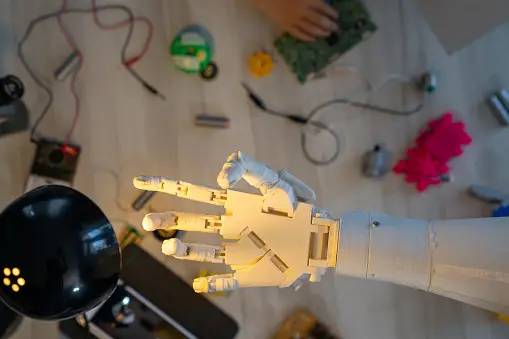
7 Surprising Ways Automation is Revolutionizing Production Lines
Welcome to the world of automation production lines! In today’s tech-driven era, industries are revolutionizing manufacturing with advanced robotics, AI, and machine learning. This blog explores how automation enhances efficiency, reduces costs, and improves product quality.
From historical roots to job impact, integrating AI for precision, promoting sustainability, and we’ll uncover 7 surprising ways automation transforms production. Get ready for a thrilling journey blending technology and industrial prowess for a brighter manufacturing future. Let’s dive in!
History of Automation in Production Lines:
The Industrial Revolution drove the history of automation production lines, spurred by the necessity for increased productivity and efficiency. Inventions such as James Watt’s steam engine facilitated mass production, while Frederick Taylor’s scientific management principles optimized workflows.
Further enhancements in automation came with the introduction of programmable logic controllers (PLCs) in the mid-20th century, enabling precise and accurate task automation. Subsequent technological advancements integrated advanced robotics, AI algorithms, and machine learning techniques across industries, to maximize efficiency and maintain quality standards.
This evolution, propelled by relentless innovation, has globally transformed production processes. From simple mechanical devices to complex interconnected systems, automation has become integral, revolutionizing the manufacturing of goods.
Key Benefits of Automation Production Lines:
Step into the dynamic world of automation, where a plethora of benefits are revolutionizing production lines across industries:
- Companies strategically maneuver human resources, fostering innovation and propelling overall business growth.
- Increased efficiency and heightened product quality ignite global competitiveness, magnetizing more customers and forging robust partnerships.
- The nimble nature of automated systems enables swift adaptation to market changes, ensuring a responsive dance to demand fluctuations.
- Integration of automation with data analytics fuels continuous improvement, uncovering optimization opportunities and propelling operational excellence.
- Environmental stewardship flourishes as resources are optimized, waste is curtailed, and energy consumption is minimized.
- Job evolution unfurls, offering skilled workers new avenues in robotics maintenance, programming, and system optimization.
- Customer delight blossoms through consistent product quality, expedited production times, and agile adaptation to preferences.
- Embracing automation ignites a blaze of technological innovation, propelling companies to the forefront of progress.
The allure of automation transcends immediate operational enhancements, leaving an indelible mark on workforce dynamics, environmental stewardship, and technological prowess. Step into the future of industry, where innovation knows no bounds.
7 Surprising Ways Automation is Revolutionizing Production Lines:
Hold on tight as we explore the game-changing ways automation is revolutionizing the world of production lines:
- Machines execute tasks with consistent precision, important in industries where precision and consistency are important, leading to Precision and Quality Improvement.
- Real-time data is leveraged to schedule maintenance before equipment breakdowns occur, minimizing downtime and avoiding disruptions through Predictive Maintenance strategies.
- Customization at scale is enabled by Agile Manufacturing, allowing quick reconfiguration of production processes to accommodate variations in product specifications.
- Human-machine collaboration opens avenues for collaborative work, with humans focusing on important thinking, creativity, and problem-solving, creating a balanced and productive work environment.
- Efficient communication and coordination between different stages of manufacturing are facilitated by Interconnected Smart Factories, contributing to a more streamlined production process.
- Waste reduction, optimized resource utilization, and minimized environmental impact promote Sustainability and Resource Efficiency.
- Beyond minimizing dangerous tasks, Enhanced Safety and Ergonomics contribute to improved workplace ergonomics and reduced physical strain.
Automation’s multifaceted impact extends beyond efficiency gains to include quality enhancement, customization, predictive maintenance, sustainability, and the cultivation of an innovative workplace culture.
Impact on the Workforce: Job Creation or Elimination?
Join the debate on automation’s impact on the workforce:
- Skill Shift and Training stress ongoing education and training to equip workers with skills for operating and maintaining automated systems.
- Collaboration between Humans and Machines involves automation augmenting human capabilities rather than replacing jobs entirely.
- Job Transformation emerges as routine tasks are automated, creating new roles in programming, maintenance, data analysis, and system oversight.
- Economic Growth may result from automation’s integration, generating new job opportunities and contributing to overall economic growth.
- Global Workforce Trends vary across industries and regions, necessitating strategies from policymakers and businesses to navigate the evolving job market.
- Social Implications emphasize the need for social policies like education and retraining initiatives to support workers transitioning to new roles.
Addressing automation’s effects on the workforce requires a multifaceted approach, acknowledging job displacement concerns while highlighting the potential for job creation, skill development, and human-machine collaboration.
Environmental Sustainability through Automation:
Discover how automation takes an important role in promoting sustainability on production lines, reducing waste, and minimizing environmental impact:
- Smart Energy Management for Reduced Carbon Footprint monitors and adjusts energy consumption, contributing to global efforts to reduce carbon emissions.
- Precise Material Usage for Resource Conservation involves automation’s precise control over material usage, reducing waste, and supporting resource conservation.
- Efficient Water Resource Management uses automated monitoring systems to identify opportunities for water conservation, contributing to responsible water resource management.
- Effective Waste Sorting for Recycling involves automated sorting systems that efficiently separate recyclable materials, promoting the circular economy and reducing environmental impact.
- Optimized Production Schedules for Inventory Reduction, achieved through the integration of AI tools with automation systems, minimized excess inventory, and prevented waste associated with obsolete or spoiled products.
- Balancing Sustainability with Productivity highlights the essential need for businesses to meet production goals while actively contributing to environmental conservation.
- Long-term Environmental Impact results from incorporating sustainable practices into operations through automation solutions, positively impacting the environment in the long term.
The integration of automation technologies in production lines enhances operational efficiency and positions industries as leaders in environmental sustainability, contributing to resource conservation, waste reduction, and overall environmental health.
Challenges and Limitations of Automation:
Reveal the challenges and limitations of automation, demanding a proactive approach for innovative solutions:
- Significant upfront costs act as a barrier, requiring substantial investment for automated system implementation, covering machinery, integration, training, and potential transition disruptions.
- A shortage of skilled labor poses a challenge, with demand for proficient robotics and automation technicians surpassing the available talent pool.
- Genuine concerns arise over employee resistance and job displacement, necessitating transparent communication and training programs to address fears of job loss and foster a positive attitude toward automation.
- Intricate integration and compatibility issues demand standardization efforts, collaboration with technology providers, and meticulous planning to achieve seamless communication between automated components.
- Rapid technological obsolescence presents a risk, prompting companies to stay updated on emerging technologies, plan regular updates, and strategically invest to avoid reliance on outdated automation systems.
- Ethical considerations surface as automation systems assume decision-making roles, requiring a balance between machine autonomy and human control, addressing accountability, transparency, and human oversight.
- The ability to overcome limitations requires continuous innovation and collaboration, which requires active participation in industry partnerships, research initiatives, and knowledge-sharing forums.
While challenges persist, they offer opportunities for innovation and enhancement. Addressing these limitations demands a proactive stance, including strategic planning, investment in workforce development, and attentiveness to ethical considerations to harness the benefits of automation.
Conclusion: Embracing the Future of Production
As automation surges in production lines, industries experience a revolution marked by unprecedented advancements in efficiency and productivity. Robots executing intricate tasks, predictive maintenance systems averting breakdowns, and data analytics optimizing operations exemplify how automation revolutionizes manufacturing.
Despite concerns about job displacement, history indicates that technological progress spawns new opportunities. Automation, coupled with AI and machine learning, fosters upskilling and the development of more complex roles for workers.
Embracing automation fosters environmental sustainability by optimizing energy usage and reducing waste. Nevertheless, challenges such as high initial costs, technical intricacies, and employee resistance require attention.
In navigating this technological transition, businesses must adapt while considering its implications. By responsibly embracing the benefits of automation and addressing its limitations, companies position themselves for long-term success and contribute to a brighter future in the production industry.



